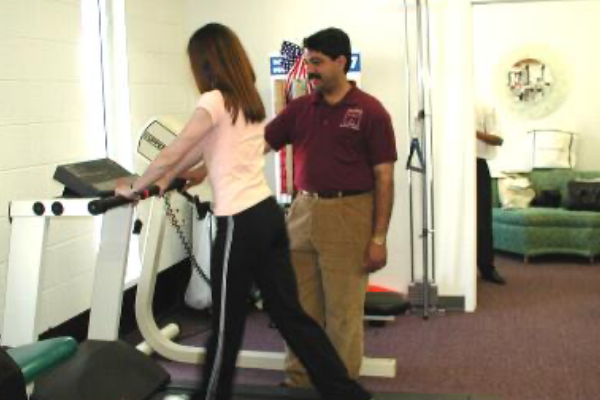Get Moving with a Physical Therapy Treatment Plan
The knee is considered a hinge joint while the hip is a ball-and-socket joint. They are both complex joints with a network of muscles, tendons, ligaments, bone, and cartilage all working together to keep you moving.
With this many moving parts, it’s not surprising that as we age or engage in strenuous activity that we sometimes experience pain.
When you’re suffering from hip or knee pain it can make doing even the most basic daily activities difficult.
Understanding the causes of hip and knee problems is often the key to effectively treating them.
If you’re struggling with hip or knee pain a physical therapist can help you reduce or even eliminate the amount of pain you’re experiencing.
Common knee and hip pain injuries
Hip and knee pain can be caused by a great number of problems.
Some of these are related to musculoskeletal misalignment, poor posture, and/or excess weight; others occur as the result of natural aging or unhealthy sports/work habits.
Your hip or knee pain may stem from:
- Infections
- Bursitis, an inflammation of the friction-reducing sacs surround the joints
- Tendinitis, or stretched ligaments
- Osteoarthritis, a painful inflammatory condition involving deteriorated joint cartilage
- Runner’s knee, an instability of the kneecap
- Postural/alignment issues that throw your body off balance, straining the knees or hips
- Traumatic injuries, such as dislocation of the joint
Our physical therapist can often tell the cause of your hip or knee pain from its location.
For example, pain along the inside of the hip is more likely to be caused by a problem with the bones or cartilage.
Pain along the outer side is typically caused by a problem in the muscles, tendons or ligaments.
Why am I experiencing hip/knee pain?
Hip Pain – Hip pain can be caused by a variety of medical conditions as well as from certain injuries. Inflamed tendons from over-exertion or an athletic injury can cause temporary or chronic hip pain. Tendinitis, dislocation, sprains, and pinched nerves can all contribute to or be the cause of hip pain. Hip pain may also result from repetitive injuries or poor posture.
Knee Pain – Injuries that include torn cartilage or damaged ligaments can cause knee pain. Fractures, tendinitis, and knee bursitis are all common knee injuries. Medical conditions such as arthritis or gout can cause mild to severe knee pain. You may be experiencing stiffness or swelling in one or both knees. It might be difficult to stand, walk, or fully straighten your knee. Sometimes knees will make popping or crunching noises.
Why should I choose PT over medication or surgery?
Surgery – Recovery from surgery can be painful and extensive. There’s always the chance of infection and sometimes surgery simply doesn’t produce the intended results. While surgery may be effective in some cases, it’s not without its drawbacks and should be used as a last resort.
Pain Medication – Prescription pain meds are sometimes used to treat knee and hip pain. Medication normally doesn’t solve the issue, but only temporarily reduces the pain. Medications, even over-the-counter meds, can be addictive and expensive.
How can physical therapy treat my hip/knee pain?
Physical therapy can offer a non-invasive solution for both hip and knee pain. A physical therapist would likely begin by conducting an evaluation.
For knee pain an evaluation would probably focus on the area from the hip to the foot. An evaluation for hip pain would likely include a spinal evaluation as well. For both types of pain an evaluation might include range of motion and strength measurements. The physical therapist may also do a gait evaluation and mobility tests.
An individualized physical therapy program would then be created for your specific needs. The American Physical Therapy Association states that early rehabilitation for certain types of knee pain is associated with a lower use of opioids and knee surgery.
Different types of exercises are often used to reduce hip pain. Passive methods such as icing or heat treatments could also be used to eliminate pain. Sometimes manipulation of soft tissues and joints in the hip or the spine is needed to restore correct movement and reduce pain.
A variety of exercises and stretches are also used to treat knee pain. Other treatments a physical therapist may use include ultrasound or electric stimulation.
Ready to begin a treatment plan?
For the best results, it’s important to follow all your physical therapist’s instructions, including any stretches or exercises that can be done at home.
Physical therapy can help you find lasting relief from hip or knee pain – contact Lake County Physical Therapy LLC today to get started!




